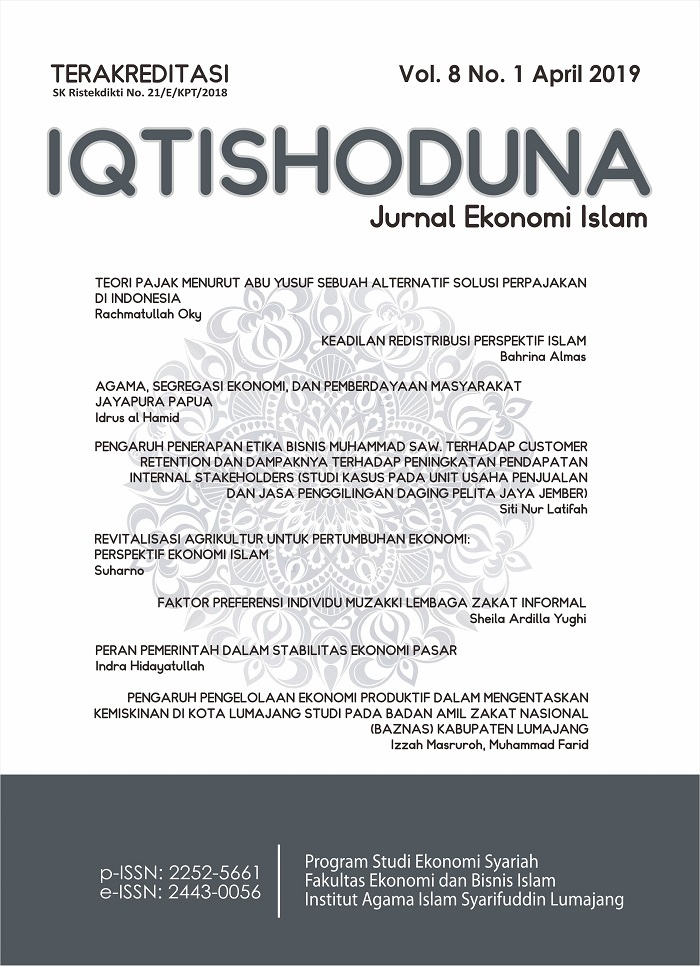Pengaruh Penerapan Etika Bisnis Muhammad Saw Terhadap Customer Retention dan Dampaknya Terhadap Peningkatan Pendapatan Internal Stakeholders (Studi Kasus pada Unit Usaha Penjualan dan Jasa Penggilingan Daging Pelita Jaya Jember)
Keywords:
Muhammad Saw Business Ethics, Customer Retention, Internal Stakeholder IncomeAbstract
This study aims to analyze the effect of the application of Muhammad Saw's Business Ethics to Customer Retention and Its Impact on Increasing Internal Stakeholder Income (Case Study in Pelita Jaya Jember Meat Sales and Milling Service Business Unit). The population in the study is all consumers who are not limited in number who are consumers in the Business Unit of Sales and Meat Milling Services of Pelita Jaya Jember, while the sampling in this study uses Quota Sampling techniques and Accidental Sampling, then set as many as 100 respondents with Accidental sampling techniques Sampling is a sampling procedure that selects samples from people or units that are easily found or accessed. This study uses Path Analysis or Path Analysis. Data were tested using the Classical Test for Normality, Heterocedasticity, Multicollinearity and Autocorrelation. Hypothesis testing is done using IBM SPSS Version 25.0. The results of the analysis show that the Business Ethics of Muhammad SAW (X) had a significant effect on Customer Retention (Z) with direct influence path coefficients of 0.566. Muhammad SAW's Business Ethics (X) has a significant effect on the Increase in Income of Internal Stakeholders (Y) with direct influence path coefficients of 0.154. In addition, Customer Retention (Z) also has a significant effect on the Increase in Income of Internal Stakeholders (Y) with direct effect path coefficients of 0.699. The indirect influence of Muhammad SAW's Business Ethics (X) on Increased Income of Internal Stakeholders (Y) through Customer Retention (Z) is significant with standardize coefficients of 0.395.
Downloads
References
Alma, Buchari .2007. Manajemen Pemasaran Dan Pemasaran Jasa. Bandung: Alfabeta.
Ang, l Dan Butte. F. 2006. Customer Retention Management Proses: A Quantitative Study, Europan Journal Of Marketing, Vol. 40:1
Anindya, Desy Astrid. 2017. Pengaruh Etika Bisnis Islam Terhadap Keuntungan Usaha Pada Wirausaha Di Desa Delituakecamatan Delitua. Jurnal: At-Tawassuth, Vol. II, No.2 Pascasarjana Akuntansi Universitas Muhammadiyah Sumatera Utara
Arif Hidayatullah, Wildan. 2016. Pengaruh Penerapan Etika Bisnis Islam terhadap Retensi Pelanggan (Studi Kasus pada Radio Suara Muslim Surabaya 93,8 FM). Jurnal Ilmiah, Malang.
Arifin,Johan. 2009. Etika Bisnis Islami. Semarang: Walisongo Press.
Arikunto, Suharsimi. 2006. Prosedur Penelitian Suatu Pendekatan Praktik. Jakarta: PT. Rineka Cipta.
Barnes, James.G. 2003. Secrets of Customer Relationship Management: Rahasia Manajemen Hubungan Pelanggan. Edisi Bahasa Indonesia. Yogyakarta: Penerbit ANDI.
Darmawati, Etika Bisnis dalam Perspektif Islam : Eksplorasi Prinsip Etis Al-Qur‟ān dan Sunnah”, Jurnal Mazahib IAIN Samarinda, (Vol). 11, No. 1, Juni 2013.
Emmet C. Murphy and Mark A. Murphy. 1 Mei 2002. Leading on the Edge of Chaos: The 10 Critical Elements for Success in Volatile Times.
Fitria. 2013. Analisis pengaruh variabel makro ekonomi dan rasio keuangan terhadap pendapatan obligasi syariah (sukuk) di Indonesia periode 2009-2011. Jurnal. Malang: UIN Malik Ibrahim.
Hadi, Sutrisno. 1991. Analisis Butir Untuk Instrumen Angket, Tes dan Skala Nilai dengan Basica. Yogyakarta: Andi Offset.
Hidayatullaili, Ratna. 2016. Pengaruh Etika Bisnis Islam Terhadap Customer Retention Nasabah Simpanan (Studi Kasus Pada BMT Universitas Muhammadiyah Yogyakarta). Skripsi. Universitas Muhammadiyah Yogyakarta
Karta Jaya, Hermawandan Muhammad Syakir Sula.2006.Syari’ah Marketing. Bandung: Mizan.
Kotler, Philip dan Keller, Kevin. 2007. Manajemen Pemasaran, alih bahasa B. Molan, cet. ke-12. Bandung: Indeks.
Latan, Hengky dan Temalagi, Selva. 2013. Analisis Multivariate: teknik dan Aplikasi menggunakan Program IBM SPSS 20.0. Bandung: Alfabeta
Muhammad. 2004. Etika Bisnis Islam. Yogyakarta : UPP AMP YKPN.
Muhammad. 2008. Metodelogi Penelitian Ekonomi Islam Pendekatan Kuantitatif. Jakarta : PT. Raja Grafindo Persada.
Priyatno, Dwi. 2008. Mandiri Belajar SPSS (Statistical Product and Service Solution: untuk analisis Data dan Uji Statistik. Yogyakarta: Mediakom.
Riduwan dan, Kuncoro, Ahmad. 2014. Cara Menggunakan dan Memaknai Path Analysis (Analisis Jalur). Bandung: Alfabeta.
Saifullah, Muhammad. 2011. Etika Bisnis Islami dalam Praktik Bisnis Rasulullah, Jurnal Walisongo, Volume 19, Nomor 1
Santoso, Singgih. 2004. SPSS Versi 14. Jakarta: Gramedia Pustaka Utama.
Sarwoko. 2005. Dasar-dasar Ekonometrika. Yogyakarta: Andi Offset.
Sugiyono. 2008. Metode Penelitian Kuantitatif Kualitatif dan R&D. Bandung: Alfabeta.
Tanjung, Hendri dan Abrista Devi. 2013. Metodologi Penelitian Ekonomi Islam. Jakarta: Gramata Publishing.
Umar, Husein. 2003. RisetSumber Daya Manusia Dalam Organisasi. Jakarta: Gramedia Pustaka Utama.
Wakhidah, Zahrotul. 2017. Pengaruh Penerapan Etika Bisnis Islam Terhadap Customer Retention Pada Baitul Māl Wat Ta Mwil (BMT) Tumang Boyolali. Tesis.Pascasarjana Institut Agama Islam Negeri (IAIN) Surakarta.
http://bahanpustakaula.blogspot.com/2015/09/empat-sifat-nabi-dalammengelolah-bisnis.html diakses tanggal 09 November 2018
https://www.literasipublik.com/antara-etika-bisnis-dan-keuntungan. 19 November 2018
https://www.maxmanroe.com/vid/organisasi/pengertian-Stakeholders.html.26 April 2018
https://www.ngdata.com/what-is-customer-retention/by molly galetto. 26 April 2018.
https://zahiraccounting.com/id/blog/ini-manfaat-penerapan-etika-bisnis-dalam-perusahaan/ diakses pada tanggal 19 November 2018
Downloads
Published
How to Cite
Issue
Section
License
Copyright (c) 2019 Siti Nur Latifah

This work is licensed under a Creative Commons Attribution 4.0 International License.
The journal can be accessed publicly, which means that all content is provided freely accessible without charge to either the user or the institution. Users are allowed to read, download, copy, distribute, print, search, or cite to the full text of the article did not have to ask permission from the publisher or author.














